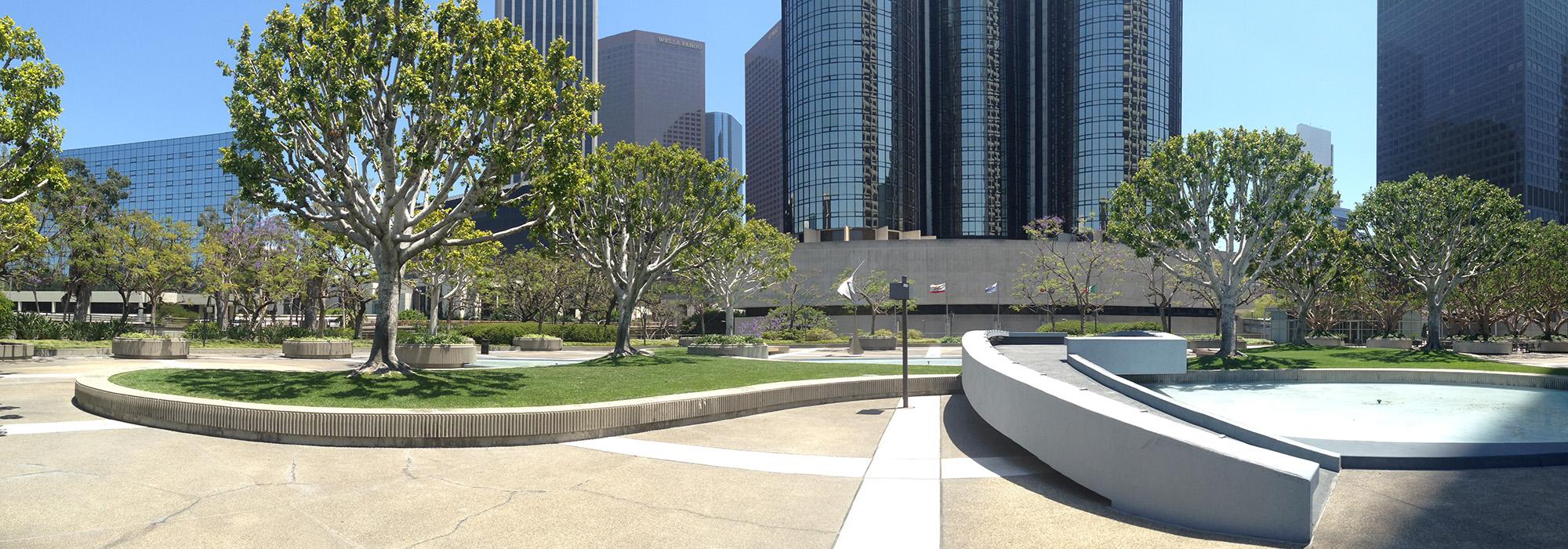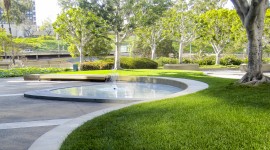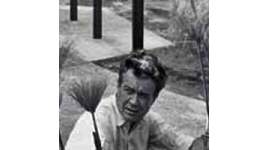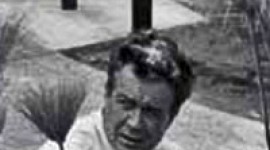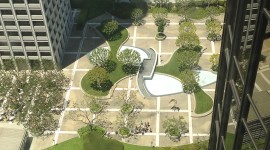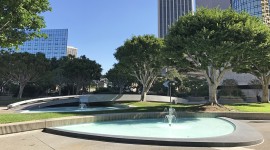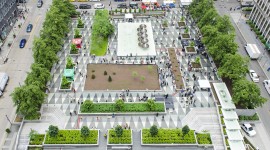Future of Garrett Eckbo’s Union Bank Plaza Uncertain
Located adjacent to the Harbor Freeway at the intersection of Fifth and Figueroa Streets, the Union Bank Plaza (originally called Union Bank Square) included the first skyscraper to be erected in downtown Los Angeles after the 150-foot height limit was repealed in 1957. Comprising a 40-story tower and a contiguous Modernist plaza, the 3.6-acre complex built in 1968 was designed by the architectural firms of Harrison + Abramowitz and Albert C. Martin Associates, working alongside legendary landscape architect Garrett Eckbo. The building and its innovative landscape have long been recognized for their iconic design, but a recently announced $20 million renovation of the property threatens to alter Eckbo’s plaza.
History
The history of the plaza began with the formulation of the Bunker Hill Redevelopment Project (BHRP) by the California Redevelopment Agency. Home to Victorian mansions and nineteenth-century luxury apartments, Bunker Hill was one of the city’s most coveted locations in the 1890s due to its scenic views of the Los Angeles Basin. But by the early twentieth century, an influx of commercial buildings and working-class tenements signalled that the wealthy had moved into more secluded neighborhoods away from downtown, and property values at Bunker Hill plummeted. In an effort to revitalize the neighborhood, the BHRP was adopted in 1959. Some 30 feet of the hillside was then razed to make the area more accessible and buildable. This new reshaped landscape was to become the center of property development and growth for downtown Los Angeles.
It is against this backdrop of urban renewal, in tandem with the removal of Victorian architecture from the neighborhood, that Union Bank Plaza was conceived. Developed by Connecticut General Life Insurance Company, the rectangular plot lies between Fourth and Fifth Street, with South Figueroa Street bordering it to the east and the Harbor Freeway and Transitway forming its western boundary. One-quarter of the 3.6-acre site is occupied by the 40-story-high Union Bank of California, designed by architects Harrison + Abramowitz of New York and Albert C. Martin Associates of Los Angeles. Just over half the parcel features a designed plaza by landscape architect Garrett Eckbo, of Eckbo, Dean, Austin & Williams.
Built in 1968, the plaza was intended to be accessed by pedestrians from the street and to be viewed from above by Union Bank employees. Known for his innovative landscape designs that have been described as “the horticultural equivalents of the architecture and furniture of Charles and Ray Eames,” Eckbo is widely regarded as one of the pioneers of Modernist landscape design.
“Site Planning...must be thought of as the organization of the total land area and airspace of the site for the best use by the people who will occupy it.”
—Garrett Eckbo, in Landscape for Living, 1950
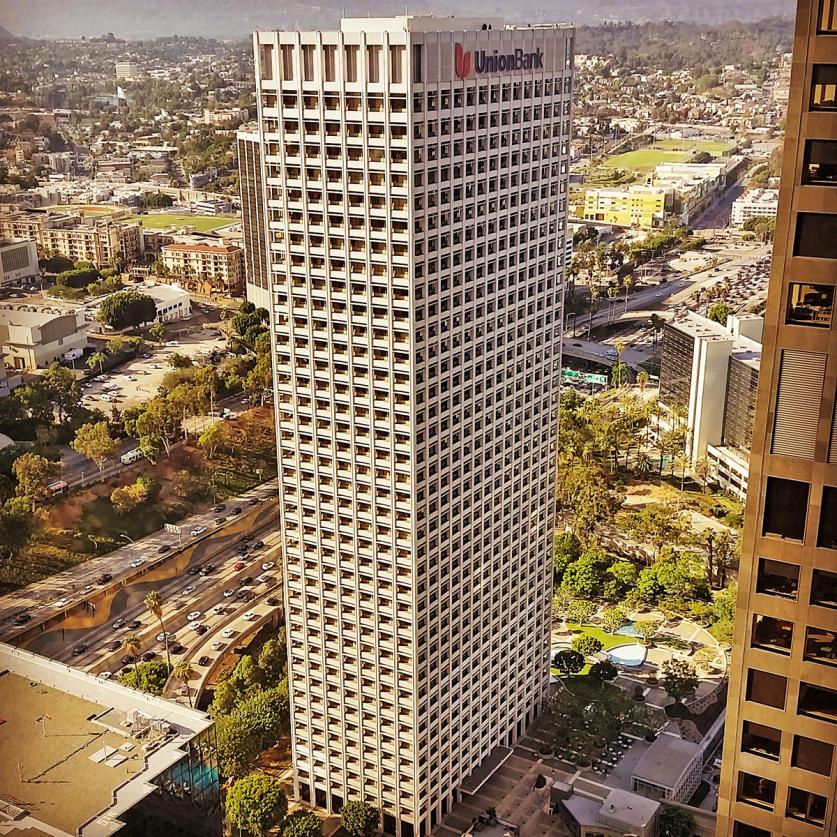
An exemplar of Eckbo’s Modernist design principles, the plaza was built two stories above street level, situated atop the commercial court and parking structure that comprise the base of the office tower. It is entered via a pedestrian bridge from the neighboring Bonaventure Hotel, a monumental staircase and elevator at Fifth Street, and discrete staircases near the freeway, making it accessible from the surrounding neighborhood. Eckbo believed this elevated position would better provide a “quiet, shaded, water-cooled retreat from the noise, confusion, and austerity of downtown streets.”
Occupying the northeastern part of the site, the plaza is formed by a circle inscribed within the lot’s rectilinear boundary and is visually organized as a grid painted into the aggregate paving. The grid is disrupted by biomorphic and organic forms that comprise a series of sculpted grass islands surrounded by water and linked by a central bridge, the whole ensemble recalling paintings by Joan Miró. The water forms a calm, still surface, with the exception of two small jets. Circular concrete planter boxes containing trees are placed at the intersections of the grid. This regimented arrangement of the trees transitions to irregular plantings and lawn areas around the perimeter of the plaza. The principal species of trees are coast coral, ficus, jacaranda, and sycamore. Framing and drawing attention to the water features is a grove of trees planted on a grid, which corresponds to the structural columns below. Notably, the design evokes a Gestalten interplay between several forms and textures—juxtaposing the linear figure of the building with the ground plane of the plaza, the orthogonality of the tower with curvilinear landscape features, and the softness of plantings with the hardness of the concrete elements. Eckbo’s original design called for a series of sculptural forms by Bella Feldmand, but these were never realized. But in 1970 Jerome Kirk's commissioned piece Aquarius was dedicated in their place.
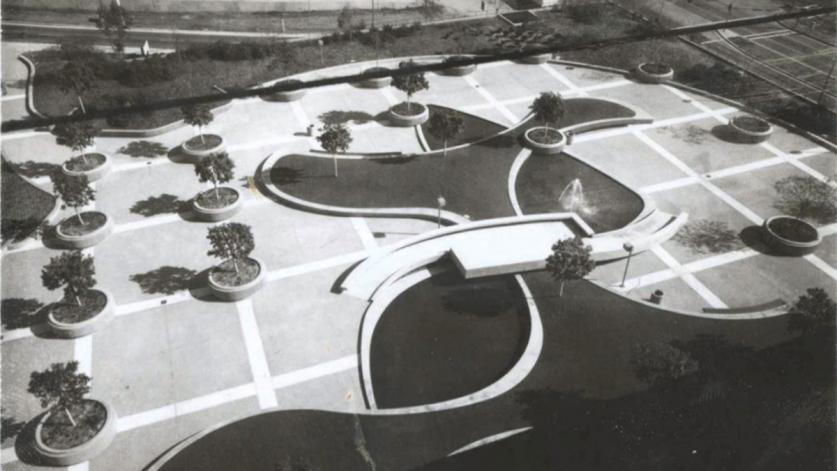
Threat
The tower and adjoining plaza are owned by KBS Realty Advisors, which, on July 9, 2019, publicly announced plans for a $20 million renovation to the plaza. According to Urbanize-Los Angeles, a local news source, KBS Senior Vice President and Asset Manager Tim Helgeson cited the complex’s location and design as the reasons for the facelift, saying “[T]here aren’t a lot of iconic buildings in Los Angeles with the amount of outdoor space and freeway accessibility that have the potential for this type of repositioning.”
Currently, the property offers 701,888 square feet of office and street-front retail space in addition to the plaza. The new plans are to include an “updated two-story retail level, a conference center, outdoor seating with fire pits and a new lobby” designed by HLW International. Additionally, new suites for so-called “live-work-play" tenants are being planned.
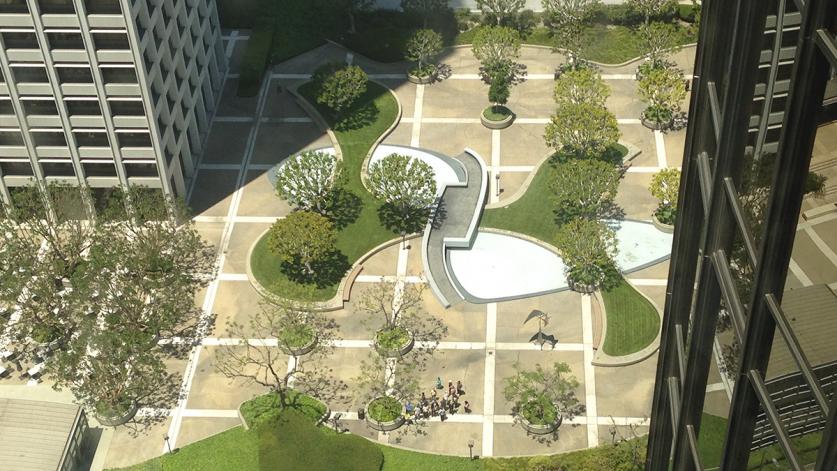
Although the plans have not been made public, the proposed renovation has been said to include a redevelopment of the lobby and the introduction of outdoor seating and fire pits. This has sparked fears that the plaza will also be a target for redevelopment, thereby erasing another work of iconic postwar landscape architecture.
Furthermore, an assessment conducted in 2015 as part of the National Park Service’s Historic American Landscapes Survey (HALS) concluded that the plaza was “in good condition,” going on to say that it is “well patronized on business days, with built elements remaining largely as they were when first constructed…Cracks in the concrete are visible, and the wood benches need repainting, but otherwise, the materials of the original construction are holding up well to the environment and usage patterns.”
The HALS report also included the following statement with regard to the plaza's significance:
The Union Bank Plaza is an intact artifact of the American Modernist movement as interpreted via landscape architecture in an urban context specifically, as opposed to the more well-known case studies from the residential realm. The plaza is also an excellent and publicly accessible representation of Garrett Eckbo's thesis on landscape architecture, and his underlying pursuit of a new visual and spatial vocabulary for organizing exterior space.
What You Can Do to Help
Aside from the comments by KBS’s senior vice president, noted above, few details of the proposed renovations have been released to the public. TCLF and local stewards are continuing to monitor the situation and will provide updates on any new developments.
Adrian Fine is the director of advocacy for the Los Angeles Conservancy and oversees the organization’s outreach, advocacy, and response on key preservation issues within the greater Los Angeles area.



